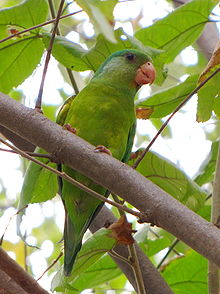- Orange-chinned Parakeet
-
Orange-chinned Parakeet 
In Venezuela Conservation status Scientific classification Kingdom: Animalia Phylum: Chordata Class: Aves Order: Psittaciformes Family: Psittacidae Genus: Brotogeris Species: B. jugularis Binomial name Brotogeris jugularis
(Müller, 1776)The Orange-chinned Parakeet (Brotogeris jugularis), also known as the Tovi Parakeet, is a small mainly green parrot of the Brotogeris genus.[1] It is found in Colombia, Costa Rica, El Salvador, Guatemala, Honduras, Mexico, Nicaragua, Panama, and Venezuela. Its natural habitats are subtropical or tropical dry forests, subtropical or tropical moist lowland forests, and heavily degraded former forest. Its name comes from a small clump of bright orange feathers located under the lower beak. Like other parrots, it is capable of imitating simple human speech.[citation needed]
Description
The Orange-chinned Parakeet is about 17.5 cm (7 in) long. It is mainly green and some of the wing feathers are brown/bronze.[1] It has a small clump of bright orange feathers under its beak, hence one of its common names; although, the orange feathers may not be visible depending of the parrots posture and the viewing angle. Its beak is horn coloured.
Behavior
The Orange-chinned Parakeet is social and forms a strong pair bond. The nest is in a tree hole. A clutch usually consist of four to six white eggs, which hatch after about 26 days of incubation. Chicks leave the nest about 42 days after hatching.[1]
References
- ^ a b c Alderton, David (2003). The Ultimate Encyclopedia of Caged and Aviary Birds. London, England: Hermes House. p. 196. ISBN 1-84309-164-X.
- BirdLife International 2004. Brotogeris jugularis. 2006 IUCN Red List of Threatened Species. Downloaded on 24 July 2007.
Categories:- IUCN Red List least concern species
- Brotogeris
- Parrot stubs
- Central America stubs
Wikimedia Foundation. 2010.


